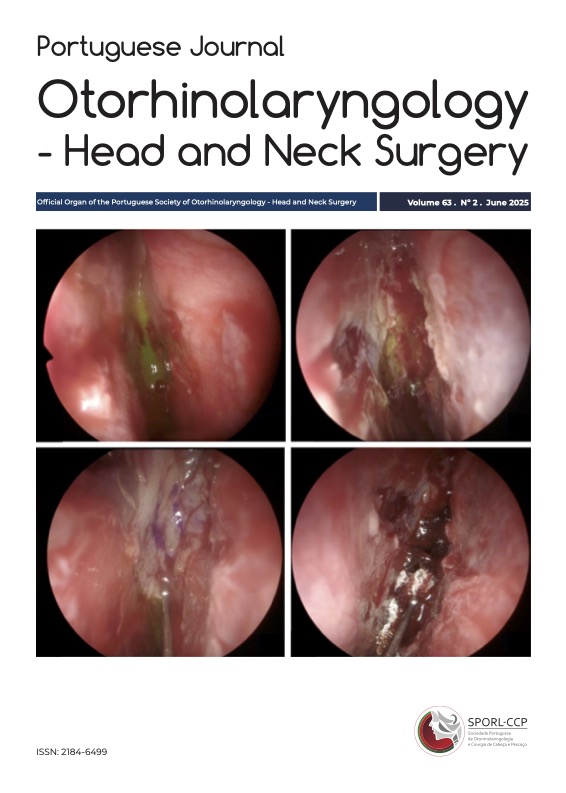Audiometric Results after Type I Tympanoplasty: Retrospective Study
DOI:
https://doi.org/10.34631/sporl.2200Keywords:
Type I tympanoplasty, Grafts, Audiological results, Hearing tests, Tympanoplasty, Cartilage, Fáscia, Treatment outcomeAbstract
Type I tympanoplasty is a common surgery in otorhinolaryngology. The main objective is to restore the integrity of the tympanic membrane, preventing infections, and improving hearing.This is a retrospective study of all patients who underwent Portmann type I tympanoplasty at the Garcia de Orta hospital in the last 10 years. The types of graft used and the pre- and postoperative audiometric results were recorded and the anatomical and audiometric success rates were analyzed.72 patients were included, with a mean age of 54 years. The study revealed a success rate of 70% in relation to closing the perforation and 60% in relation to closing the air-bone gap. The best graft in terms of closure was the temporal fascia + cartilage, a statistically significant result. In terms of closure of the air-bone gap, it was the temporal fascia, but it was not statistically significant. The anatomical and audiometric results are comparable to those published in the literature.
Downloads
References
Mangia LRL, Amadeu NT, da Silva Oliveira M, Patzer LS, Somensi ES, Hamerschmidt R. Success rates and predictors of outcomes of type I tympanoplasty performed by residents in a teaching tertiary hospital. J Otol. 2023 Oct;18(4):214-219. doi: 10.1016/j.joto.2023.09.003.
Fukuchi I, Cerchiari DP, Garcia E, Rezende CE, Rapoport PB. Tympanoplasty: surgical results and a comparison of the factors that may interfere in their success. Braz J Otorhinolaryngol. 2006 Mar-Apr;72(2):267-71. doi: 10.1016/s1808-8694(15)30067-7.
Lagos A, Villarroel P, García-Huidobro F, Delgado V, Huidobro B, Caro J. et al.Tympanoplasty: factors associated with anatomical and audiometric results. Acta Otorrinolaringol Esp (Engl Ed). 2020 Jul-Aug;71(4):219-224. doi: 10.1016/j.otorri.2019.07.003.
Al-Khtoum N, Hiari MA. Myringoplasty in children: retrospective analysis of 35 cases. Braz J Otorhinolaryngol. 2009 May-Jun;75(3):371-4. doi: 10.1016/s1808-8694(15)30654-6.
Batni G, Goyal R. Hearing outcome after type I tympanoplasty: a retrospective study. Indian J Otolaryngol Head Neck Surg. 2015 Mar;67(1):39-42. doi: 10.1007/s12070-014-0749-8.
Kolo ES, Ramalingam R. Hearing results post tympanoplasty: our experience with adults at the KKR ENT Hospital, India. Indian J Otolaryngol Head Neck Surg. 2014 Dec;66(4):365-8. doi: 10.1007/s12070-012-0588-4.
Jalali MM, Motasaddi M, Kouhi A, Dabiri S, Soleimani R. Comparison of cartilage with temporalis fascia tympanoplasty: a meta-analysis of comparative studies. Laryngoscope. 2017 Sep;127(9):2139-2148. doi: 10.1002/lary.26451.
Tan HE, Santa Maria PL, Eikelboom RH, Anandacoomaraswamy KS, Atlas MD. Type I tympanoplasty meta-analysis: a single variable analysis. Otol Neurotol. 2016 Aug;37(7):838-46. doi: 10.1097/MAO.0000000000001099
Downloads
Published
How to Cite
Issue
Section
License
Copyright (c) 2025 Mariana Neto, Sílvia Alves, Sofia Teles, Catarina Areias, Henrique Teixeira, Luís Antunes

This work is licensed under a Creative Commons Attribution-ShareAlike 4.0 International License.






